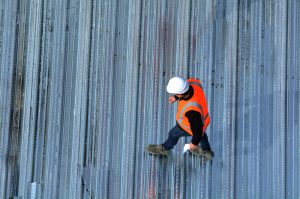Well, 2017 is upon us and one of my New Year’s resolution is to start an OSHA related blog and this is one resolution I am committed to keeping (unlike a few others that have already fell by the wayside unfortunately).
I know it may not sound like a particularly interesting subject for a blog or perhaps a bit unusual to some, but if you are reading this, I suspect you probably do not fall into either of those camps. We are the safety and health “nerds” of the world and a group which, to be blunt, probably doesn’t get enough recognition but that’s a subject for a future blog.
To start, I wanted to share some of the reasons workplace safety is so important to me and also talk about some of my hopes and objectives in writing this blog.
Let me start with who I am. My formal legal background can be viewed under the “About the Author” link on this blog. For additional information about my experience, I welcome you to visit my bio on Cozen O’Connor’s website located here.
For my entire professional career I have been involved with workplace safety and health issues. Immediately after law school, I started as a trial attorney with the United States Department of Labor where I prosecuted, among other laws, OSHA. At DOL, I quickly grew to understand the importance of workplace safety and witnessed the tragedies that could take place when workplace safety is not a priority. Read More
About The Author
 In a prior blog we discussed OSHA’s new electronic recordkeeping rule which requires, among other things, certain employers to submit injury and illness data.
In a prior blog we discussed OSHA’s new electronic recordkeeping rule which requires, among other things, certain employers to submit injury and illness data. Congress granted the Secretary of Labor the authority to enter places of employment to conduct safety and health inspections. The OSH Act provides that such inspections must take place at reasonable times, within reasonable limits and in a reasonable manner and that they may include inspection of relevant conditions, structures and other equipment. For a general description of the inspection process, OSHA has published a Fact Sheet which is available
Congress granted the Secretary of Labor the authority to enter places of employment to conduct safety and health inspections. The OSH Act provides that such inspections must take place at reasonable times, within reasonable limits and in a reasonable manner and that they may include inspection of relevant conditions, structures and other equipment. For a general description of the inspection process, OSHA has published a Fact Sheet which is available  In a prior blog, we discussed OSHA’s recently enacted anti-retaliation rule which says, among other things, that employers cannot deter injury and illness reporting or retaliate against employees for such reporting. The rule itself does not expressly address drug-testing but the preamble makes clear that OSHA believes mandatory post-accident drug testing would be retaliatory. However, OSHA further stated that mandatory post-accident drug testing to comply with the requirements of a state or federal law or regulation is permissible. Mandatory post-accident testing to receive workers’ compensation discounts is also lawful. In other words, such testing would not be retaliatory because there is a lawful and valid reason that permits or requires such testing.
In a prior blog, we discussed OSHA’s recently enacted anti-retaliation rule which says, among other things, that employers cannot deter injury and illness reporting or retaliate against employees for such reporting. The rule itself does not expressly address drug-testing but the preamble makes clear that OSHA believes mandatory post-accident drug testing would be retaliatory. However, OSHA further stated that mandatory post-accident drug testing to comply with the requirements of a state or federal law or regulation is permissible. Mandatory post-accident testing to receive workers’ compensation discounts is also lawful. In other words, such testing would not be retaliatory because there is a lawful and valid reason that permits or requires such testing. As of January 13, 2017, employers will be subject to higher fines for safety and health violations but not by much – 1.01636 percent to be precise. The increase matches the annual consumer price index by the federal government as of October 2016. The new maximum OSHA fines are:
As of January 13, 2017, employers will be subject to higher fines for safety and health violations but not by much – 1.01636 percent to be precise. The increase matches the annual consumer price index by the federal government as of October 2016. The new maximum OSHA fines are: In the last blog, we took a look data showing a decrease in OSHA workplace safety and health inspections in 2016. Although this may be true for safety and health inspections, it is certainly not for whistle-blower investigations which continue to rise. Some may not be aware that OSHA enforces and investigates claims under 22 different federal whistleblowing laws including, among others, Section 11(c) of the OSH Act, the Safe Drinking Water Act, Sarbanes-Oxley, the Surface Transportation Assistance Act and the Consumer Financial Protection Act of 2010.
In the last blog, we took a look data showing a decrease in OSHA workplace safety and health inspections in 2016. Although this may be true for safety and health inspections, it is certainly not for whistle-blower investigations which continue to rise. Some may not be aware that OSHA enforces and investigates claims under 22 different federal whistleblowing laws including, among others, Section 11(c) of the OSH Act, the Safe Drinking Water Act, Sarbanes-Oxley, the Surface Transportation Assistance Act and the Consumer Financial Protection Act of 2010. There are lot of questions about how the Trump administration will affect OSHA in the next four years including who will lead the agency. The President has already implemented a federal hiring freeze although there are some exceptions built into the mandate. However, it is probably a safe bet to assume we probably will not see an increase in OSHA enforcement and most likely a shift from enforcement to compliance assistance as federal budgets will likely shrink.
There are lot of questions about how the Trump administration will affect OSHA in the next four years including who will lead the agency. The President has already implemented a federal hiring freeze although there are some exceptions built into the mandate. However, it is probably a safe bet to assume we probably will not see an increase in OSHA enforcement and most likely a shift from enforcement to compliance assistance as federal budgets will likely shrink.